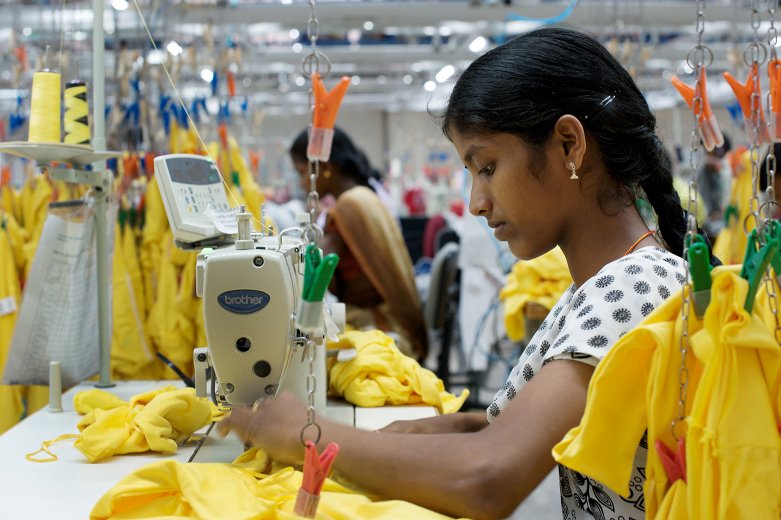Overseas Factories Vary
I've visited hundreds of factories in dozens of countries on multiple continents. I've seen factories at both ends of the spectrum. The best are highly modern, air-conditioned, state-of-the-art facilities with restaurant-quality cafeterias, banking services, on-site nurses and recreational facilities for the workers. The worst was a shed-like structure with holes in the roof where the only toilet was a bank of doorless stalls with holes in the floor, jutting out over, and open to, the slow-moving, mud-colored creek ten feet below.
Most factories fall somewhere between these two extremes. Recreational facilities and air conditioning are rare and workers usually bring their own lunches. Most of the production is done by individual sewing-machine operators, who are paid by the piece and perform the same operation over and over to achieve management's production targets. One constant remains no matter where the factory is located, or where it lies on the spectrum. Workers on the factory floor are overwhelmingly women. In developing nations, women comprise 80% of the apparel workforce. These women do tedious work for long hours, often in unsafe conditions– far from home, and for minimal wages.
Global Standards for Factories
In the 1980s and into the 1990s, there were no global standards for evaluating factories. Each brand or business set its own standards and employed its own inspectors to determine which factories could produce acceptable product in acceptable conditions.
These standards varied widely. In the quest for ever more production at ever more attractive prices, many brands have moved production from more expensive to less expensive countries. Bangladesh has one of the lowest labor rates on earth; its apparel industry growth is a good illustration of this process. In 1989, the United States imported about 200,000 garments from Bangladesh. In 2019, Bangladesh was the second largest exporter of apparel to the US after China – an increase driven by U.S. customers' demand for lower prices.
Sub-standard Factories Will Find Customers
As a sourcing manager for Victoria's Secret, I visited many factories which would not meet our standards and were therefore rejected, but nonetheless, these factories continued to produce garments for export to the United States under other, less-discerning brand names.
In the mid-1990s, Americans became aware of sub-standard working conditions in factories through a number of venues, but most well-known was the 1996 Wal-Mart story involving the Kathie Lee Gifford brand name. The brand produced clothing allegedly made by 13- and 14-year-old children working 20-hour days in Honduras.
This was followed closely by a 1997 scandal when it was reported by The New York Times that managers in a Vietnam production facility producing shoes for Nike were abusive to workers. Forbes magazine has deemed Nike and Kathie Lee Gifford the parents of Corporate Social Responsibility (CSR) as a result of the awareness fostered by these events. CSR has certainly become a defining characteristic for apparel, footwear, and other industries.
Efforts to Improve Work Conditions
The Department of Labor's Bureau of International Affairs leads one effort to ensure workers around the world are treated fairly. In 1993, they created an office specifically focused on child labor, forced labor and human trafficking, which publishes an annual report titled, Findings on the Worst Forms of Child Labor. As you can imagine, the details are sobering. Although increased scrutiny and better self-monitoring by brands has helped, nearly 170 million children worldwide are thought to be working in unhealthy and unsafe conditions.
Unfortunately, as the insatiable demand for low-cost apparel grew, laws and regulations related to the safety, health and well-being of factory workers did not keep pace. Protections that we take for granted, such as minimum age requirements to prevent child labor, work-place safety regulations, and environmental safeguards, either do not exist or are ignored in many countries. Recent incidents illustrate that there is still much work to be done to improve working conditions across the globe.
In 2012, a Saks Fifth Avenue customer found a note tucked into her shopping bag after making a purchase. The note was written by a prisoner in China, an English teacher from Cameroon This teacher alleged he was wrongfully arrested on fraud charges, and held in a Chinese prison for ten months. He wrote that he was being tortured and asked for help. He was released from prison and left China before the note was discovered in a bag he had been forced to produce while working sixteen-hour days. Production of goods by prisoners is considered forced labor and it is illegal to import such goods into the United States.
Factory Safety Requires Diligent Efforts
In the face of such tragedies, so far away, it's natural to feel hopeless. It seems impossible to have any influence on such widespread, systemic problems.
Finally, Global Brands Adopt Stricter Policies
However, these multiple tragedies in Bangladesh led to an outcry over the deaths and devastated lives of survivors. And triggered a cry for global brands to take responsibility for ensuring safe production conditions and a call for stricter laws and government oversight and enforcement. This has led many brands to adopt stricter policies to ensure the safety and ethical treatment of workers.
WRAP Standards and Factory Certification
One way for customers to identify factories with ethical practices is to look for WRAP certification. The Worldwide Responsible Accredited Production group, or WRAP, is a non-profit organization formed in 1997 to provide an objective and independent body to help apparel and footwear industry companies ensure the factories they use are in compliance with ethical and moral standards.
None of the factories in the Rana Plaza building had been certified by WRAP. If the they had been WRAP-certified, it's quite possible that the problems which led to the building's collapse, or the fire at Tazreen, would have been avoided.
- Compliance with Laws and Workplace Regulations
- Prohibition of Forced Labor
- Prohibition of Child Labor
- Prohibition of Harassment or Abuse
- Compensation and Benefits
- Hours of Work
- Prohibition of Discrimination
- Health and Safety
- Freedom of Association and Collective Bargaining
- Environment
- Customs Compliance
- Security
All Lucky & Me Factories WRAP Certified
WRAP's certification program is the largest in the world. WRAP provides training to help factories learn how to internalize these principles to develop a culture of social and ethical responsibility. WRAP also offers a Factory Fire Safety Awareness course which teaches factory workers safety procedures including how to prevent fires, conduct fire drills, and operate fire-fighting equipment.
What I like about WRAP is that it is comprehensive and independent. If a factory is WRAP-certified, you can be sure that it has undergone a rigorous program of self-evaluation and outside auditing and review to ensure compliance with the standards set for all twelve WRAP principles. This means there has been an on-site review of the factory's policies and practices relating to social and ethical considerations, including worker health and safety, age, freedom, hours, and compensation as well as environmental, Customs and security measures.
I believe that if more companies required the factories they use to be WRAP-certified, there would be better and safer working conditions for workers across the globe. There has been a great deal of progress made in improving the working conditions at factories throughout the world since 1996. A major factor in this movement has been increased customer awareness of conditions under which their clothing is produced. This has led to more intensive scrutiny of brands, which in turn has led to a rise in independent certifications, such as WRAP.
Lucky & Me takes social responsibility very seriously and their factories in India and Sri Lanka are WRAP-certified. One of these factories is RM Holdings, in Sri Lanka. WRAP certification ensures that RM Holdings takes social and ethical responsibility seriously, and that the conditions for all workers are safe, healthy and not abusive.
We can play a role in improving the lives of millions of women who toil in garment factories to make clothing for our kids (and ourselves) by realizing that the few pennies we save on a pair of underwear or a blouse quite likely compromises the well-being of the person who stitched them. We must require the brands and stores we patronize to demonstrate they value the people who make their products everywhere.
By Liz Smith. Liz has worked across the globe for many of the world's best known apparel brands, including Justice, Chico's, Victoria's Secret, and Hanes. She has worked closely with dozens of factories in more than 20 countries to ensure that production is of the highest standard. Liz has managed all aspects of garment production, from design through fabric development to sewing and merchandising - so she knows what it takes to make high-quality apparel. Liz is thrilled to share her knowledge about clothes to help discerning customers choose the finest products.


